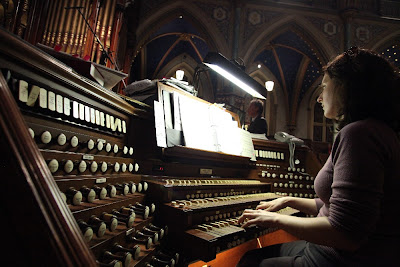THE MASS OF THE HOLY OILS
THE MASS OF CHRISM
On Tuesday evening, the Archdiocese of Ottawa gathered for the Mass of Chrism; some photos (courtesy of Robert Du Broy):
 |
| Pouring balsam into the olive oil before consecration of chrism |
 |
| a large number of priests took part |
 |
| the organist |
 |
| blessing the people during the recessional |
 |
| the reception in the parish hall |
On Holy Thursday morning or a date nearby (in Ottawa it is on the Tuesday evening of Holy Week), the bishop and the priests of the diocese gather at the Cathedral to celebrate the Chrism Mass, sometimes referred to as the Mass of the Holy Oils). This Mass manifests the unity of the priests with their bishop.
Here the bishop blesses three oils — the oil of catechumens (oleum catechumenorum or oleum sanctorum [OS on some vessels]), the oil of the infirm (oleum infirmorum [OI]) and holy chrism (sacrum chrisma [SC]) — which will be used in the administration of the sacraments throughout the diocese for the year.

This tradition is rooted in the early Church as noted in the Gelasian Sacramentary (named after Pope Gelasius I, d. 496), but was later absorbed into the Holy Thursday evening Mass; Pope Pius XII issued a new Ordinal for Holy Week, which reinstituted a special Mass of the chrism distinct from the evening Mass.
Throughout the Bible, various references indicate the importance of olive oil in daily life. Oil was used in cooking, particularly in the making of bread, that basic food substance for nourishment (e.g. Nm 11:7-9); as a fuel for lamps (e.g. Mt 25:1-9); and as a healing agent in medicine (e.g. Is 1:6 and Lk 10:34). Moreover, with oil the Jews anointed the head of a guest as a sign of welcome (e.g. Lk 7:46), beautified one’s appearance (e.g. Ru 3:3) and prepared a body for burial (e.g. Mk 16:1).
In religious practices, the Jews also used oil to offer sacrifices (e.g. Ex 29:40); to dedicate a memorial stone in honor of God (e.g. Gn 28:18); and to consecrate the meeting tent, the ark of the covenant, the table, the lampstand, the laver, the altar of incense, and the altar of holocausts (e.g. Ex 31:26-29). The use of oil was clearly a part of the daily life of the people.
Sacred Scripture also attests to the spiritual symbolism of oil. For instance, Psalm 23:5 reads, “You anoint my head with oil,” signifying favor and strength from the Lord; and Psalm 45:8 reads, “You love justice and hate wickedness; therefore, God your God, has anointed you with the oil of gladness above your fellow kings,” signifying the special designation from God and the joy of being His servant.
Moreover, to be “the anointed” of the Lord indicated receiving a special vocation from the Lord and the empowerment with the Holy Spirit to fulfill that vocation: Jesus, echoing the words of Isaiah, spoke, “The spirit of the Lord is upon me; therefore, He has anointed me” (Lk 4:18). St. Paul emphasized this point, “God is the one Who firmly establishes us along with you in Christ; it is He Who anointed us and has sealed us, thereby depositing the first payment, the Spirit in our hearts” (2 Cor 1:21). Therefore, the symbolism of oil is rich sanctification, healing, strengthening, beautification, dedication, consecration and sacrifice.
Given this heritage, the early Church adopted the use of olive oil for its sacramental rituals. The Oil of Catechumens is used in connection with the sacrament of baptism. St. Hippolytus, in his Apostolic Tradition (A.D. 215), wrote of an “oil of exorcism” used to anoint the candidates immediately before baptism. This practice continues: In the current baptismal liturgy, the priest offers the prayer of exorcism and then with the oil of catechumens anoints the person to be baptized on the chest, saying, “We anoint you with the oil of salvation in the name of Christ our Savior; may He strengthen you with His power, Who lives and reigns forever and ever.”
Anointing with the oil of catechumens following a prayer of exorcism may also take place during the period of the catechumenate on one or several occasions. In both cases this anointing symbolizes the person’s need for the help and strength of God to sever the bondage of the past and to overcome the opposition of the devil so that he may profess his faith, come to baptism and live as a child of God.
The oil of the infirm is used in the sacrament of the anointing of the sick. St. James wrote, “Is there anyone sick among you? He should ask for the priests of the Church. They in turn are to pray over him, anointing him with oil in the name of the Lord. This prayer uttered in faith will reclaim the one who is ill, and the Lord will restore him to health. If he has committed any sins, forgiveness will be his” (Jas 5:14-15).
The Apostolic Tradition of St. Hippolytus recorded one of the earliest formulas for blessing the oil of the infirm. Also, in the early Church, a priest (or several priests) would bless this oil at the time it was to be used, a tradition that has been retained in the Eastern Churches. However, in the Latin Rite, at least since the time of the Middles Ages, priests have used oil blessed by the bishop; for instance, St. Boniface in 730 ordered all priests in Germany to use the oil of the infirm blessed by bishops only.
Presently, the priest, anointing the forehead of the person, says, “Through this holy anointing, may the Lord in His love and mercy help you with the grace of the Holy Spirit,” and then anointing his hands, says, “May the Lord who frees you from sin, save you and raise you up.” Another body part may also be anointed if the hands are not accessible or if there is another particular need.
Finally, holy chrism is a mixture of olive oil and balsam, an aromatic resin. This oil is linked with the sanctification of individuals. In the Old Testament times, the priest, prophets and kings of the Jewish people were anointed. This oil is used in the sacraments of baptism, confirmation, and holy orders, since they impart an indelible sacramental character.
The blessing of the holy chrism is different from that of the other oils: Here the bishop breathes over the vessel of chrism, a gesture which symbolizes both the Holy Spirit coming down to consecrate this oil, and the life-giving, sanctifying nature of the sacraments for which it is used. (Recall how our Lord “breathed” on the Apostles on the night of Easter, saying, ‘Receive the Holy Spirit’” (Jn 20:22).)
The concelebrants at the Chrism Mass also extend their right hands toward the chrism as the bishop says the consecratory prayer, signifying that in union with their bishop they share “in the authority by which Christ Himself builds up and sanctifies and rules His Body,” the Church (Vatican II, Decree on the Ministry and Life of Priests, No. 2).
Regarding baptism, St. Hippolytus in the Apostolic Tradition spoke of an anointing after the actual baptism with the “oil of thanksgiving.” Similarly, right after the actual baptism in the present rite, the priest anoints the person on the crown of the head with chrism, saying, “God the Father of our Lord Jesus Christ has freed you from sin and given you a new birth by water and the Holy Spirit. He now anoints with the chrism of salvation. As Christ was anointed Priest, Prophet and King, so may you live always as a member of His body, sharing everlasting life. Amen.”
In the sacrament of confirmation, the bishop anoints the forehead of the candidate with chrism saying, “Be sealed with the gift of the Holy Spirit.”
Sacred chrism is also used in the sacrament of holy orders. In the ordination rite of a priest, the bishop anoints with chrism the palms of each new priest. In the ordination rite of a bishop, the consecrating bishop anoints the head of the new bishop.
Finally, holy chrism is used in the dedication ceremony of a church. Here the bishop anoints the altar, pouring holy chrism on the middle of the altar and on each of its four corners. It is recommended that the bishop anoint the entire altar. After anointing the altar, he anoints the walls of the church in 12 or four places marked by crosses.
As our bishop blesses these three oils at the Chrism Mass this year, our hearts turn to our gracious Lord who bestows His infinite love and mercy to us through these sacraments. Let us also pray for our bishop and the priests who are the ministers of the sacraments in the parish, that they may be the humble and generous servants of the Lord (--Father William Saunders, Arlington Catholic Herald).
* * * * * *
HOLY THURSDAY
Today's liturgy marks the Lord's three-fold institution of the Eucharist, the Priesthood and the Commandment of Fraternal Love:
Prayer for Holy Thursday
of the Lord’s Supper
Grant to those, O God, who participate in this most sacred Supper, in which your Only Begotten Son, when about to hand himself over to death, entrusted to the Church a sacrifice new for all eternity, the banquet of his love; that drawing upon so great a mystery we may have fullness of charity and of life. Through our Lord.

No comments:
Post a Comment